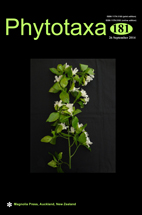Abstract
In the genus Xanthoparmelia, species boundaries are based on morphological and chemical features such as the presence and/or absence of secondary metabolites, diagnostic reproductive structures, isidia morphology, and color of lower surface. Two new species of Xanthoparmelia are described from South Korea, X. kolriana with cylindrical isidia containing atranorin and salazinic acid as major components in the medulla together with cortical usnic acid, while X. volcanicola is characterised by a red coloured medulla, and subglobose isidia. The characteristics of Xanthoparmelia species and their distribution in South Korea are outlined and an identification key given. Additionally, we used ITS ribosomal DNA sequences to assess the monophyly of Xanthoparmelia species from South Korea. Our results reveal that traditionally circumscribed species were not recovered as monophyletic clades. Further, we here show that ITS is insufficient to estimate a well-supported phylogenetic hypothesis, but suggests that traditional taxonomy may not reflect natural groups. This communication provides an important framework for future studies assessing species boundaries in Xanthoparmelia species in South Korea.

